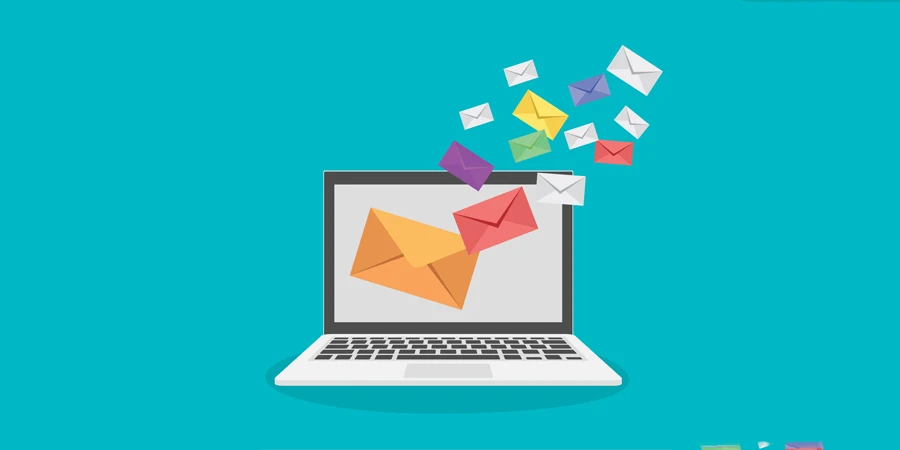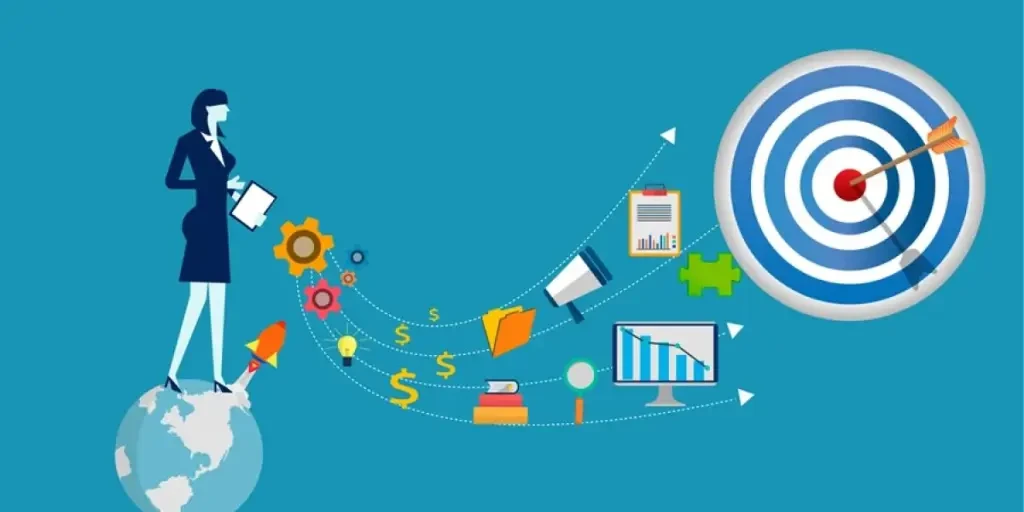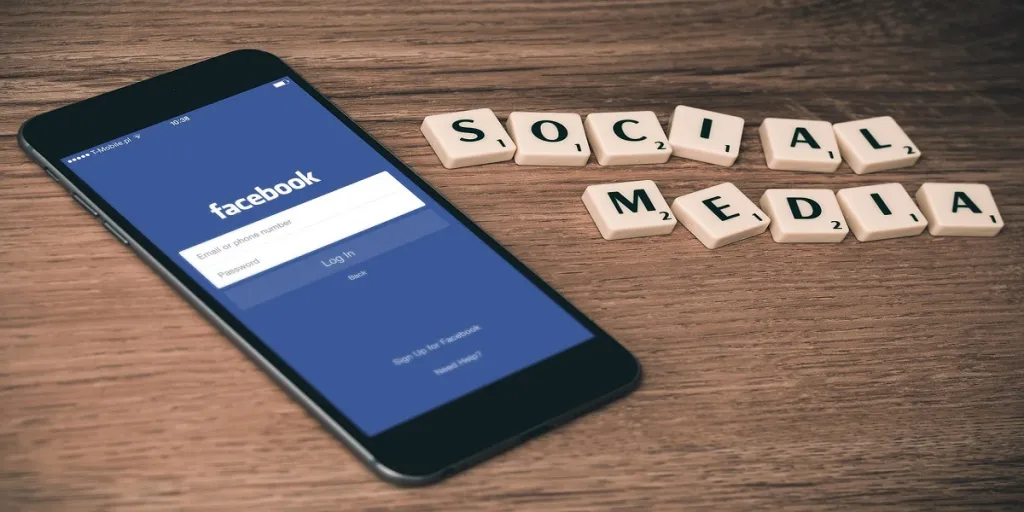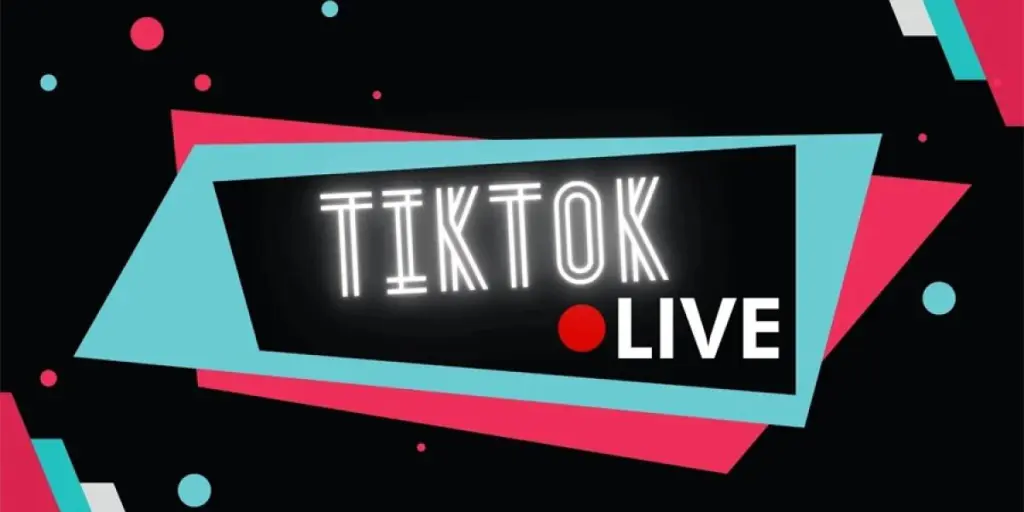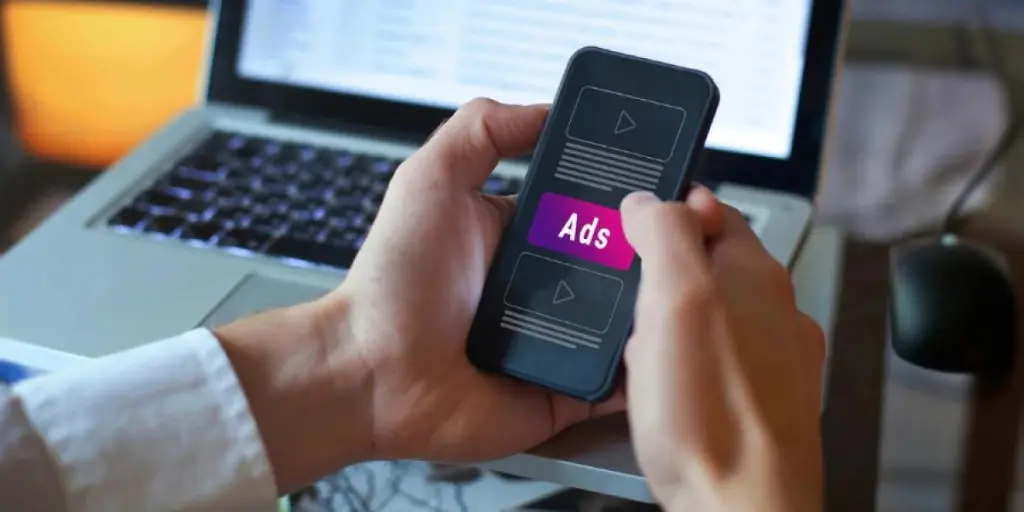Table of Contents
1. What is an email drip campaign?
2. Creating an effective email drip campaign linked to the customer journey
3. Final thoughts
One of the biggest challenges in marketing is targeting customers with the right messages at the right time.
When emailing customers, meeting them where they are in the buyer’s journey is important. Are they looking for a general answer to a problem? Or do they want to know more about your product and brand before they make a purchase?
Sending emails that answer such questions is the key to driving conversions and building trust. And this is where email drip campaigns come in. A well-executed email drip campaign can help you shorten the time a customer takes between doing research and buying your product. It can also boost conversions and build trust.
Keep reading our guide to learn everything you need to know about effective email drip campaigns to support your customers’ buying journey.
What is an email drip campaign?
An email drip campaign is a series of pre-scheduled, automated email messages sent to subscribers or potential customers over a period of time. The key purpose of drip campaigns is to nurture prospects and leads by providing helpful information and resources based on their interests and needs.
Drip campaigns work by setting up a sequence of emails that automatically trigger based on a schedule or your customers’ actions. For example, an ecommerce business can set up a five-email drip campaign that sends coupons and product recommendations to customers after they make their first purchase.
The main benefits of email drip campaigns include:
- Keeping your brand top of mind with subscribers through ongoing and continuous email touchpoints
- Delivering targeted, personalized content matched to the subscriber’s journey
- Driving conversions by sending emails when recipients are most likely to take action
- Automating nurture campaigns to increase engagement and build trust
- Seamlessly integrating email with other marketing channels to amplify your messaging
By creating relevant email drips mapped to the customer journey, you can build stronger relationships and boost loyalty over time.
Creating an effective email drip campaign linked to the customer journey
Let’s break down all the steps in planning and creating an email drip campaign for successful engagement and sales.
1. Understand the customer journey
The customer journey typically consists of five main stages: awareness, consideration, acquisition, retention, and advocacy.
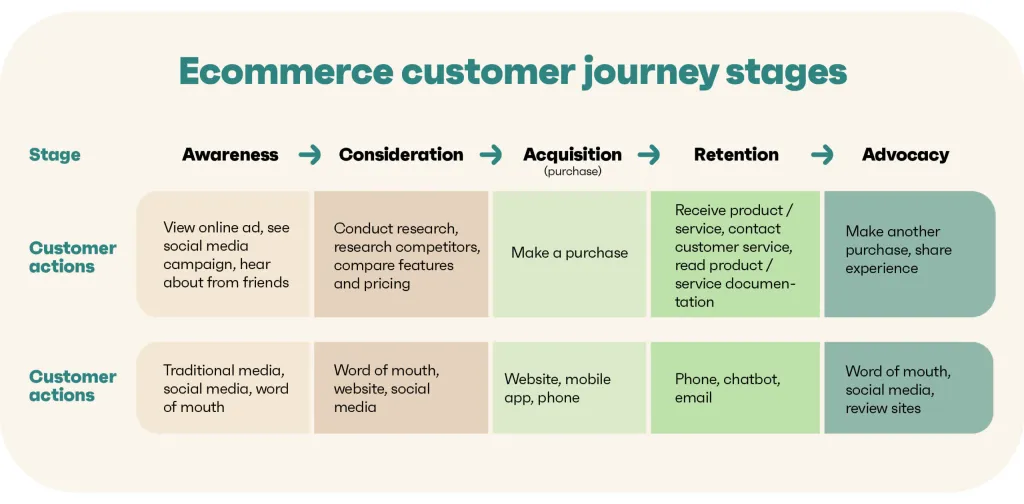
At each stage, customers have different needs and goals that impact how they interact with a business.
- Awareness stage: Here, your customer is aware of a problem in their lives and is looking for general information. For example, they might ask, ‘Why is my plant turning brown?’
- Consideration stage: Now, the customer knows they have a problem and is actively seeking solutions. For example, they might search for ‘the best ways to revive a dying plant.’
- Acquisition stage: The customer is ready to choose a solution to their problem and looking for detailed information. For example, they might need information on the best plant foods available or seek replacement plants and want to find a nursery nearby.
Once customers find the most useful and practical solution, they’ll likely buy a product or service to meet their needs. For businesses, the customer journey can have two more stages:
- Retention stage: After you successfully sell to customers, you can continue your relationship and communication with them. If you’re a plant nursery or a plant food company and a customer bought from you, you could build loyalty through discounts on future purchases or by following up with content on caring for a plant.
- Advocacy stage: Here, you turn satisfied customers into evangelists or advocates. Do this with referral programs, affiliate marketing setups, or by creating giveaways.
When you understand the customer journey, you can map your email campaigns to each stage. This ensures that your messaging resonates better and drives customers closer to conversions and loyalty.
Your emails should provide value and anticipate customer needs at different points in their journey.
2. Map email campaigns to each stage
Email marketing campaigns should be tailored to each stage of the customer journey to create the best effect. A drip email campaign can provide information and content that goes from the awareness to the advocacy stage. Let’s explore what this looks like.
Awareness stage
Your initial emails in your drip campaign must link to the early informational goals your customers have. Let’s say people sign up for your newsletter to learn more about search engine optimization (SEO) — your first email(s) can include the following types of content:
- Welcome and introduction emails for new subscribers explaining your expertise and knowledge in SEO and what they can expect from your newsletter
- Educational content building their knowledge of basic SEO concepts like keywords, domain authority, backlink building, and so on
- Invitation to join a social media group for further communication and interactions with other community members
Here, you’re helping your readers build their knowledge and also setting the stage for more promotional content further down the line.
An example of an automated drip campaign starting with a welcome email:
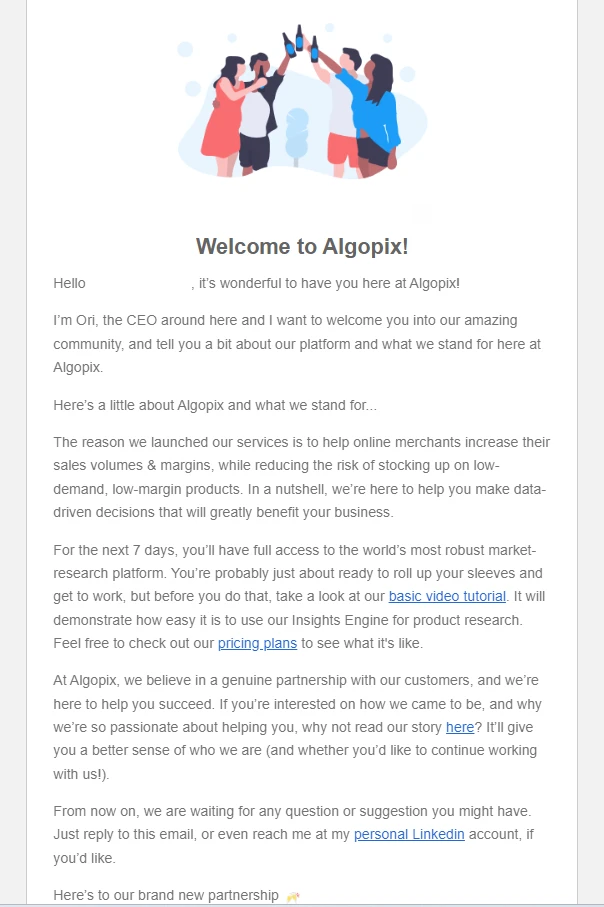
Consideration stage
At the consideration stage, your customers are ready to delve deeper into solutions that can help them. This is your moment to provide more detailed, solution-oriented content.
- Emails that introduce different products or services you offer related to SEO
- Comparison emails on your various product offerings, highlighting their features and benefits
- Case studies and success stories from customers who have used your products/services to achieve results
At this stage, it’s important to showcase how your offerings can specifically address the needs of your customer and solve their problem.
This follow-up email is part of a drip campaign and encourages readers to learn more as part of the consideration stage:
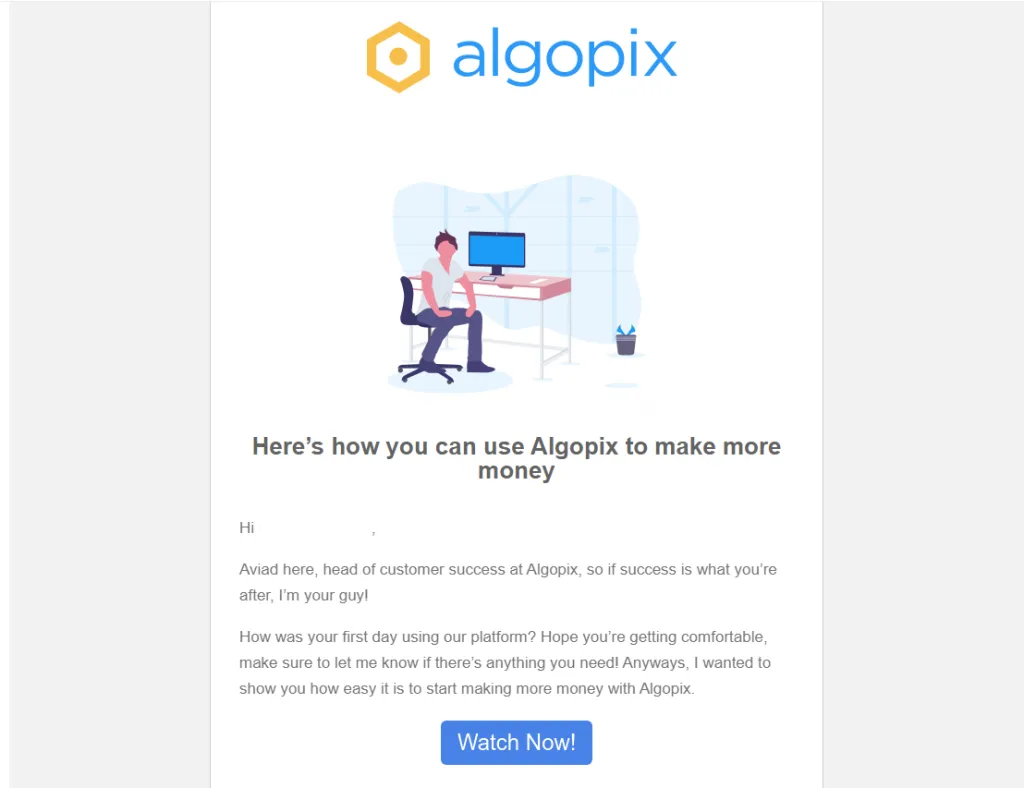
Acquisition stage
When your customers are at the decision stage, they’re ready to make a purchase or commit to a specific solution. Your emails should provide that final push towards buying from you.
- Email series highlighting limited-time offers or discounts on products/services related to SEO
- Testimonials and reviews from satisfied customers who have used your offerings to improve their SEO efforts
- Personalized emails offering guidance or tips on how to make the most out of your products/services for SEO success
- Special discounts, free trials, limited-time offers, and emails with calls to action are ideal here
This is where you can showcase the unique value and benefits of choosing your business over others in the market.
Here’s an example of a drip campaign that launches when a free trial expires. It helps boost purchasing by offering discounts and a time-limited offer.

Retention stage
After a customer has made a purchase, it’s important to continue nurturing the relationship with them through your email campaigns. This will help build loyalty and encourage repeat business.
- Thank you emails to show gratitude for their purchase and offer any additional support or resources
- Exclusive discounts or rewards for continued purchases from your business
- Educational content on how to make the most out of their recent purchase and enhance their overall experience with your brand
By providing value even after a sale, you can increase customer satisfaction and foster long-term relationships with your audience.
Advocacy stage
You should also plan to turn satisfied customers into advocates for your business. Your email campaigns at this stage should focus on building a community and encouraging customers to become brand ambassadors.
- Create emails announcing referral programs or rewards for customers who refer their friends and family to your business
- Showcase exclusive opportunities for customers to become affiliates and earn commissions for promoting your products/services
- Set up giveaways or contests that encourage customers to share your brand on social media or with their networks
By leveraging the power of word-of-mouth marketing, you can expand your reach and gain new customers by advocating for your satisfied customer base. Hint: ask customers who leave five-star reviews to take action on your behalf. This will ensure you get active participation and more customers.
Mapping email campaigns allows you to provide valuable and relevant content at every stage of the customer’s journey. You also guide customers towards making a purchase easily and increase your sales.
3. Segment your audience
Segmenting your audience is crucial for the success of your email campaigns, as it allows you to tailor your messaging to the specific needs and interests of different groups within your customer base.
To segment your audience effectively, consider various criteria that can help you identify the specific characteristics of your customers:
- Previous interactions: Knowing how customers have interacted with you before, such as signing up from a specific blog or clicking a social media link, can help tailor future content more effectively
- Purchase history: Looking at what products or services your customers have bought in the past can help you tailor your messaging to recommend related items or upsell higher-value products
- Engagement level: Measure how engaged customers are with your emails by looking at open rates, click-through rates, and other engagement metrics
- Demographics: Information such as age, gender, location, and occupation can be useful for segmentation
- Behavioral data: Analyze how customers behave on your website and other platforms, e.g., look at your most visited pages and highest downloads to segment customers
What is the benefit of segmenting your email audience?
There are several benefits that come from personalization and mapping your emails to your customer journey. You get increased engagement, higher customer satisfaction scores, more sales, greater long-term loyalty, and the most efficient use of your resources.
Email list segmentation is crucial to the success of your drip campaigns and ensures you get a good return on your investment and efforts in email marketing.
4. Tailoring content and messaging
Now, let’s look at clear tips for tailoring your content and messaging at every stage. We’ve already laid out some ideas in the section on mapping your emails to the customer journey. Here are more tips:
- Do your research using SEO tools like AIOSEO, Semrush, and Ahrefs to learn what people are looking for related to your content
- Focus on providing value in all your emails versus pushing for a sale, e.g. by answering the ‘what, why, where, how, and when’ of a problem your customer faces
- Also, create value by sharing success stories, case studies, industry tips, and special offers that are unavailable anywhere else
- Keep a consistent tone of voice when writing emails — switching from a sales-like tone to a dry informational one will give readers whiplash, so create tone of voice guidelines and ensure that you stick to it in all your content
Final tip: Consider reader feedback and make changes to your communication when necessary. If you’re willing to listen to them, your readers often have powerful insights and can help you learn better ways to market.
5. Optimize timing and frequency
When you launch your email campaigns, the time between each email matters.
You should also be careful about how many emails you send altogether when creating drip campaigns.
The best way to optimize timing and frequency is to rely on data, analytics, and testing.
Look at your email marketing dashboard and conduct split tests to check the most effective days and times to send emails. You could send a small batch of emails to see how people respond. Then, send more based on your results.
A/B testing different email frequencies allows you to gauge engagement at each stage of the journey. For example, you could test daily, weekly, or monthly emails for prospects. Analyze your open and click-through rates to identify the optimal frequency.
Best practices recommend starting with more spaced-out emails and then increasing frequency for highly engaged users. Sending too many emails risks annoying recipients or coming across as spammy. On the other hand, emailing too infrequently can cause customers to forget about your brand.
Finally, set up automated schedules and triggers tailored to customer segments and behaviors. For example, send follow-up emails when a specific action occurs, such as opening a previous email or clicking a link. Other behaviors like website visits, downloads, and purchases are also helpful for figuring out the best times and frequencies for sending your drip emails.
6. Measure performance and iterate
You can measure the performance of your drip campaign by tracking important metrics.
Here are the most important ones to follow over time:
- Open rate
- Click-through rate
- Conversion rate
- Unsubscribe rate
- Spam rate
An uptick in your open rates, click-through rates, and conversion rates is a good sign. It indicates that your email drip campaign is working, and you should continue to use it.
On the other hand, your emails getting marked as spam or having an increase in unsubscribes hints at problems.
You need to analyze these metrics over time and identify trends and patterns in engagement. As you make changes to your campaign, you should observe changes in your performance and use this information to make improvements.
How can you leverage A/B testing to boost your drip campaign?
For starters, test your subject lines, send times, content formatting, calls-to-action, and other elements.
Testing and iteration allow you to optimize your campaign for higher open and click-through rates.
7. Integrate with other marketing channels
One underestimated way to make your email drip campaign successful is to coordinate your efforts with other channels like social media campaigns, content marketing, and advertising. Doing so will help you reinforce your messaging and create a seamless customer experience.
For example, integrate email with social media to drive traffic back to your website. You could promote your email newsletter on social media or share your blog content via email. This enables all channels to support and enhance the effectiveness of your marketing campaigns.
Use automation tools to integrate different channels. You can ensure consistency in branding, messaging, imagery, and tone by using AI and image editing platforms.
Today, AI can quickly repurpose materials like blog posts and emails into social media content, checklists, ebooks, and video scripts.
This way, you can enable your email content to align with your overarching content strategy and marketing calendar. And having such supporting content for different stages of the customer journey only reinforces your messaging.
We maintain a consistent brand experience in my business in the following ways:
- We set out and document our brand palette, style, tone of voice, colors, and so on
- We develop templates that our team can use with a few edits and tweaks
- We have a single person or a close team handling one brand so that they have deep expertise in every aspect of the brand and can ensure our emails and other communication stay the same
- We leverage editing tools and AI to repurpose and scale up the production of branded content
Integrating email drip campaigns with other marketing channels adds more weight to your communication. It provides customers with multiple content formats and helps them make a decision to buy from you sooner.
Final thoughts
When executed effectively, email drip campaigns can provide immense value throughout the customer journey. By mapping relevant email sequences to each stage of the journey, you can nurture prospects, educate leads, and drive conversions at scale.
Use this guide to make email drip campaigns an invaluable component of your marketing stack.
As you build your audience and learn how to use it effectively, you’ll automate your sales and earnings.
Author Bio

Syed Balkhi is the founder of WPBeginner, the largest free WordPress resource site. With over 10 years of experience, he’s the leading WordPress expert in the industry. You can learn more about Syed and his portfolio of companies by following him on his social media networks.
Source from Omnisend
Disclaimer: The information set forth above is provided by omnisend.com independently of Alibaba.com. Alibaba.com makes no representation and warranties as to the quality and reliability of the seller and products.
